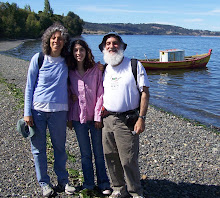So, the next day, it was natural that we thought of Semana Santa (Holy Week) when we saw a group of young men, dressed in torn clothing with dirt and ashes on their faces, begging for spare change on a street corner in El Plan (the downtown trafficky urban center of Valparaíso, which is completely different from the tranquilo hill where we live).  These were not your typical beggars; these were young healthy men, the age of college students, who looked like they were engaged in some form of street theater. When one of them approached us to ask for spare change, we asked him if what they were doing was something religious, connected to Semana Santa. Oh no, no, this was completely different. These were, as they appeared, college students. (Most of the colleges in the city had begun classes the previous week or two for the fall semester.) The quick explanation that we received was that this begging was something all the incoming freshmen had to do – some sort of initiation rite. Oh, it’s like hazing, we thought.
These were not your typical beggars; these were young healthy men, the age of college students, who looked like they were engaged in some form of street theater. When one of them approached us to ask for spare change, we asked him if what they were doing was something religious, connected to Semana Santa. Oh no, no, this was completely different. These were, as they appeared, college students. (Most of the colleges in the city had begun classes the previous week or two for the fall semester.) The quick explanation that we received was that this begging was something all the incoming freshmen had to do – some sort of initiation rite. Oh, it’s like hazing, we thought.
We then started seeing students everywhere, dressed in torn clothing, covered with colorful paint, on their clothes, faces and hair, young men and women, all asking for change. 
We asked these young women if we could take their picture, telling them we had a son in college back in the states. 
Purim happened to fall in the middle of this same week – and on Thursday night we went to the sinagoga to share in the celebration, bearing with us Hamantaschen that we had made that morning (thanks to the rapid response of both Rick Nathan and Sandy Cohen to our frantic emails the day before seeking Hamantaschen recipes.) Here are some pictures from Purim –
Jonathan was invited to chant some passages from the Megilah and Linda was asked to talk a little about the Megilah she had scribed for
and Linda was asked to talk a little about the Megilah she had scribed for 
Following the service, Rabino Roberto Feldmann led everyone in singing and dancing around the refreshments table.


Semana Santa concludes, of course, with Easter Sunday. During the week, up in the hills, we had seen children carrying what looked like straw men, which we were told were figures of Judas. On Easter Sunday, we saw two of these Judases set up in the plazuela near our home and we were asked to donate coins for the burning of Judas. (In fact two groups of eager young boys competed for our coins, each arguing the merits of their particular Judas.) We learned that the burning of Judas would take place that evening at
 By
By 
 We then discovered the purpose of the coins “for the burning of Judas”.
We then discovered the purpose of the coins “for the burning of Judas”.

Apparently, they had been put inside the Judases, like candies inside a piñata. As the Judas burned and his limbs disintegrated, the coins inside came tumbling out onto the street and eager children scrambled to retrieve them. “I’ve got enough money for chocolate!” Linda heard one young girl shout to a friend.
It was a friendly, multi-generational crowd, not so very different from the crowd that might be gathered in a synagogue to boo Haman and celebrate his demise at the end of the book of Esther. There is something universal in this desire to celebrate the triumph of good over evil – and to cheer the downfall of the one identified as wicked. Yet, we felt rather squeamish watching Judas burn. Perhaps it was our awareness that in other places, at other times, not so very long ago, the burning Judases would not have been cloth or paper figures, but real Jews. Or perhaps it was because, in general, burning human figures is something we associate with political or religious extremism, whether it is in the

